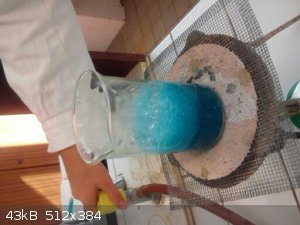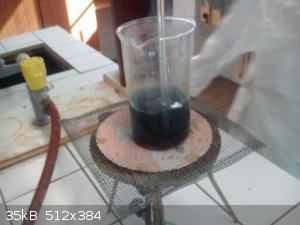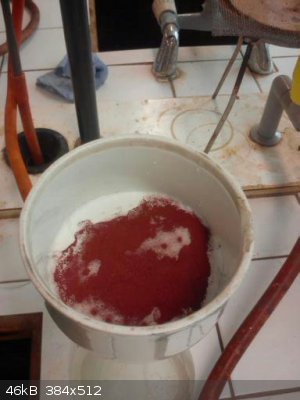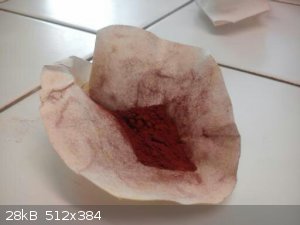rka
Harmless

Posts: 2
Registered: 26-5-2017
Member Is Offline
Mood: No Mood
|
|
Chemical reduction of copper nitrate
I have CuNO3 solution containing some excess HNO3. Is there a method, other than electrolytic, to get Cu (powder or solid metal form) from it?
<I>Edit by moderator : Added more descriptive title<I>
[Edited on 5-27-2017 by gdflp]
|
|
|
Neme
Hazard to Self
 
Posts: 86
Registered: 28-5-2016
Location: Czech republic
Member Is Offline
Mood: No Mood
|
|
You can add some metal with enough negative electrode potencial to replace it. When I was still in my highschool We did it with iron nails:
Fe + CuSO4 --> FeSO4 + Cu
I attach some pictures from my highschool lab.
   
|
|
|
AJKOER
Radically Dubious
    
Posts: 3026
Registered: 7-5-2011
Member Is Offline
Mood: No Mood
|
|
As you have excess HNO3, I would first add a source of pure metal copper to remove the acid and create more copper nitrate. Limit air access to the
solution (reducing the likelihood of an electrochemical reaction similar to rust formation). Separate any unreacted copper from the solution and
dilute with previously boiled distilled water (to remove oxygen).
Caution, very corrosive and toxic fumes! Best performed outdoors with protective gear.
Then, perform the iron metal replacement of copper with a piece of carbon steel. In other words, avoid an iron alloy with transition metals as even a
small introduction of some transition metals (like cobalt) can have significant effects (both positive and negative) in subsequent reactions
employing the tainted copper. An example of a good thing is the creation of a so called redox couple if performing a Fenton/Fenton-like reaction with
the acidified transition metals collected. A negative example would be the formation of a galvanic couple introducing a small current, which with
time, could create unexplained products.
[Edit] My speculation as to the possible mechanics of the impact of a galvanic couple on a salt solution with time would be as follows:
H2O = H+ + OH-
H+ + e- = .H
.H + .H → H2 (g) [ but with dissolved O2 a faster reaction, .H + O2 → HO2 = H+ +.O2- restoring H+ ! ]
Net:
H2O + e- → 1/2 H2 + OH-
Implying a possible path to a rising pH, but absent dissolved oxygen (from say boiling a solution in open air). So, in a closed vessel (limiting the
presence of air/O2 and mixing thereof), a point could be reach where, perhaps, a basic salt precipitates out of solution (seemingly on just standing).
The educational literature, see for example, https://en.m.wikibooks.org/wiki/A-level_Chemistry/AQA/Module... notes that "Aqueous solutions of transition metal ions are thus acidic'" as a
result of there tendency to form ligands which undergo deprotonation, like, for example:
[Cu(H2O)6]2+ (aq) + H2O (l) = [Cu(H2O)5(OH)]+ (aq) + H3O+ (aq)
and in the presence of a base, or I would argue e-, can thus form a precipitate.
Note, air itself contains particulate matter including transition metals and zinc (see, for example, http://pubs.acs.org/doi/abs/10.1021/cr040649c ). The presence of Zn could induce the formation of a galvanic couple in presence of a soluble
transition metal.
[Edited on 27-5-2017 by AJKOER]
[Edited on 27-5-2017 by AJKOER]
|
|
|
Metacelsus
International Hazard
    
Posts: 2531
Registered: 26-12-2012
Location: Boston, MA
Member Is Offline
Mood: Double, double, toil and trouble
|
|
That's a waste of copper. You could just evaporate the excess nitric acid, or neutralize it with a base (such as sodium hydroxide or ammonia). If you
do neutralize it, make sure not to add too much base, or you will get copper hydroxide precipitation.
Also, I would suggest electrolysis to deposit the copper rather than displacement with another metal. Collecting the copper would be simpler, and it
would also avoid introduction of impurities from the other metal.
[Edited on 5-27-2017 by Metacelsus]
|
|
|
gdflp
|
Thread Moved
27-5-2017 at 05:05 |
AJKOER
Radically Dubious
    
Posts: 3026
Registered: 7-5-2011
Member Is Offline
Mood: No Mood
|
|
In my opinion, as copper is everywhere (copper wires, plumbing,...as scrap) and HNO3 is not, more likely a waste of nitric acid.
Also, Fe reacts with dilute HNO3 forming H2 or with concentrated nitric acid forming problematic NO2 along with a passivation layer (see https://en.m.wikipedia.org/wiki/Nitric_acid ).
Assuming you have carbon steel electrodes for your suggested electrolysis, any plated out Cu will react with unremoved HNO3 (with the copper thus
returning to solution) and some of the NOx could be liberated with part not escaping the system, permitting a partial recycling of acid. In other
words, there is an ongoing 'waste' of copper, unless you suggest boiling together with the electrolysis, or have otherwise completely removed the
excess HNO3.
Finally, when done, one has to scrap off the copper without introducing any iron.
[Edited on 27-5-2017 by AJKOER]
|
|
|
|